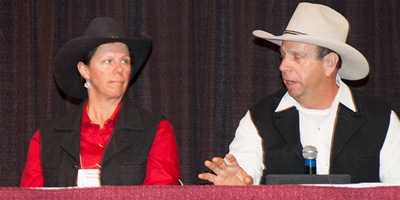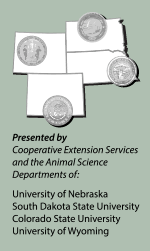Integrating Conservation Programs Into Rangeland Management
by Troy Smith, field editor, Angus Journal
RAPID CITY, S.D. (Dec. 4, 2013) — Their shared goal of ranch ownership was achieved in 2007 when Al and Simone Wind purchased a spread near Newell, S.D. As a result of persistent drought and previous management, the property was not in good condition. During the Range Beef Cow Symposium in Rapid City, S.D., Al and Simone talked about developing and implementing a plan for improving the ranch. Assisting with the couple’s presentation were representatives of conservation groups and agencies that are assisting in ranch restoration efforts.

Al and Simone described problems that existed at the time of purchase of their ranch near Sewell, S.D.
Al and Simone described problems that existed at the time of purchase. Range condition was poor on much of the ranch, with evidence of moderate to severe overgrazing. Riparian areas showed evidence of erosion. Normally shallow creek channels were deeply cut, with steep banks that supported minimal vegetation. There were few of the native species of trees and shrubs normally present in the region’s healthy riparian areas. Some wildlife species typically found in riparian areas were absent.
A management plan was drafted to address problems limiting the ranch’s productivity as a grazing resource and as wildlife habitat. Planned improvements and practices included fencing to separate riparian areas from surrounding uplands, plus cross-fencing to facilitate planned rotational grazing management. Fencing around perimeters of stock dams was installed to control livestock impact. Stock water quality and distribution was improved with the installation of pipelines, additional water tanks and both wind- and solar-powered pumps. Along with native grass restoration, shrubs and trees were planted in selected areas to help manage erosion and improve habitat.
“We envisioned what we wanted the ranch to be 10 and 20 years down the line, and planned what we could do to get there,” said Al, emphasizing that the plan was adaptive and subject to periodic review and revision.
Matt Stoltenberg, project coordinator for the Belle Fourche River Watershed Partnership, explained how his group coordinated input — guidance and cost-share assistance — for improved management practices. Participating “partners” included the Natural Resources Conservation Service; U.S. Fish and Wildlife Service; South Dakota Department of Game, Fish and Parks; and South Dakota State University Cooperative Extension.
“The effort attracted multi-agency involvement because there was much potential for improvement on the ranch, and because of Al and Simone were passionate about doing it,” said Stoltenberg.
U.S. Fish and Wildlife Service representative Steve Fairbairn said managing grasslands for improved grazing also benefits wildlife. That fact makes his agency a willing, cost-sharing partner. He and other agency representatives agreed that the Wind Ranch monitoring system shows that positive change is occurring. Measuring progress also shows how the management plan might be tweaked to better achieve its stated goals.
The Winds spoke Wednesday at RBCS XXIII. Visit the Newsroom at www.rangebeefcow.com/2013 to view their PowerPoint, read their proceedings paper or listen to their presentation.
---------------------
The RBCS is a biennial educational symposium offering practical production management information. It is sponsored by the Cooperative Extension Service and animal science departments of the University of Wyoming, South Dakota State University, Colorado State University and the University of Nebraska.
Comprehensive coverage of the symposium is available online at www.rangebeefcow.com. Compiled by the Angus Journal editorial team, the site is made possible through sponsorship of LiveAuctions.tv and the cooperation of the host committee.
Editor’s Note: This article was written under contract or by staff of the Angus Journal. To request reprint permission and guidelines, contact Shauna Rose Hermel, editor, at 816-383-5270.


